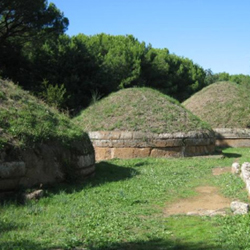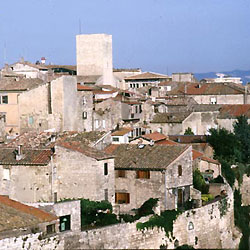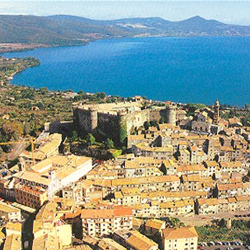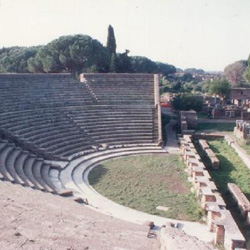Lazio Tours
Roman Villas | Etruscan, Ostia Antica | The Roman Castles | Ciociaria
Etruscan, Ostia Antica
The suggested tour is a visit through the most important Etruscan Necropoli of Cervetri, Tarquinia and Ostia Antica. The importance of the Etruscan Necropoli is connected to the fact that the domestic environment of the deceased was reconstructed in their tombs and their lives were represented through paintings, decorations and objects. This patrimony has made possible to study the history and customs of the Etruscan people. The Vatican museum has from 1837 a large collection of antiquities excavated in the area.
Suggested day tour of the surroundings of Rome with the visit of Cerveteri, Tarquinia, Bracciano and Ostia Antica, the service is driver/guided and is individually personalized.
Roman Villas | Etruscan, Ostia Antica | The Roman Castles | Ciociaria
Etruscan, Ostia Antica
The suggested tour is a visit through the most important Etruscan Necropoli of Cervetri, Tarquinia and Ostia Antica. The importance of the Etruscan Necropoli is connected to the fact that the domestic environment of the deceased was reconstructed in their tombs and their lives were represented through paintings, decorations and objects. This patrimony has made possible to study the history and customs of the Etruscan people. The Vatican museum has from 1837 a large collection of antiquities excavated in the area.
Suggested day tour of the surroundings of Rome with the visit of Cerveteri, Tarquinia, Bracciano and Ostia Antica, the service is driver/guided and is individually personalized.
| Cerveteri. In the heart of Tuscia, on the slopes of the Tolfa mountains, Cerveteri has gained world-wide fame for its Etruscan burial grounds and, in particular, the Necropolis of Banditaccia, declared World Heritage Site in 2004 by UNESCO. The Necropolis of Banditaccia, also known as the "city of the dead", was designed as if it were to be inhabited by living beings. From the principal thoroughfare of "Via degli Inferi", there are a number of secondary roads lined with dozens of circular burial mounds, dug in to the tuff. The interiors of the tombs are similar to those of an Etruscan house. The Tomba dei Rilievi (Tomb of the Reliefs, 3rd century BC) is by far the most decorative, its walls painted with images of domestic animals and various utensils for every day use. It was in these tombs that many of the artefacts now displayed in the world's most important museums were found. An important collection of relics is conserved in the Cerite National Archaeological Museum, located in the 13th century castle which dominates the historic center of Cerveteri. Facing on to the principal square of the town, Palazzo Ruspoli is one of the most important buildings in the medieval center, together with the Church of Santa Maria: built in the 1950's and which incorporates a section of a pre-existing Romanesque church. Just a few kilometers separate the center of town from the splendid beach of Marina of Cerveteri. |
 |
| Tarquinia. Tarquinia, town where to discover Lazio's Etruscan past. The high relief sculpture of two winged horses, which once pulled a chariot mounted by a god, have become the symbol of the town, and can be seen on an immense terracotta panel housed within Tarquinia's National Archaeological Museum, together with hundreds of other unique exhibits, from elaborate funeral outfits to exquisite pieces of jewellery. Just a few kilometers from the sea, in the province of Viterbo, the town of Traquinia rests on a hill opposite that on which the ancient Etruscan settlement of Civita once stood. Halfway between the old and new town, lies the Monterozzi Necropolis, now an UNESCO World Heritage Site. This burial ground contains some six thousand tombs, sixty of which decorated with elaborate wall paintings, and offers visitors the opportunity to admire the oldest works of art present on Italian territory. Those wishing to take a journey back in time should visit "Etruscopolis": perfect reconstruction of an Etruscan town. Tarquinia still conserves much of its medieval town center, including numerous towers and a Castle in which, legend has it, Matilde of Canossa once stayed. Tarquinia is also home to beautiful houses of worship such as the Cathedral, and the 12th century Church of Santa Maria in Castello, this latter with magnificent Rose window.
|  |
| Bracciano. A medieval fiefdom, complete with fairytale castle, gazing out across a lake. This is how Bracciano appears to the many visitors coming to admire this enchanting little town in the province of Rome. Lake Bracciano which, with its 57 square kilometers, is the second largest of Lazio's lakes, is of volcanic origin, formed in the crater of an extinct volcano. The lake is the destination for a number of important sailing events. One of the most scenic spots from where to view the lake is that occupied by the Odescalchi Castle. Erected in the latter half of the 15th century by the Orsini, the castle has an irregular quadrilateral form and six cylindrical towers. In 1695 it was purchased by the Odescalchi family, who still own the building. Inside the castle walls, visitors have the opportunity to admire the Papalina Library and a series of magnificent reception halls, such as the Sala dei Cesari, the Sala degli Orsini and the Sala d'Armi. Well worth visiting: the castle kitchens in which there is a fascinating collection of old cooking utensils, and the secret garden: a hanging garden of 1800 square meters which faces directly on to the lake. In the historic center of Bracciano, characterised by its maze of picturesque medieval lanes and alleyways, there are a number of terraces overlooking the lake. Not to be missed: the Cathedral of Santo Stefano and the Church of Santa Maria Novella, this latter commissioned by the Cardinal Giordano Orsini. |  |
| Ostia Antica. Ostia Lido is Rome's beach. During the summer months hundreds of holiday makers, many of whom travelling on the trains which depart each day from the station of Ostiense, arrive on the golden beaches of Ostia, so as to bask in the sunshine and enjoy the services offered by the well equipped bathing establishments which populate this stretch of coast. Those interested and wishing to see more than a few paving stones of the old Roman empire should head for the Archaeological Park of Ostia Antica, where to observe the remains of temples, piazzas, baths and public meeting places: all of which testify to the existence of an important settlement at the mouth of the river Tiber, thought to have had a population of some 50,000. |
 |